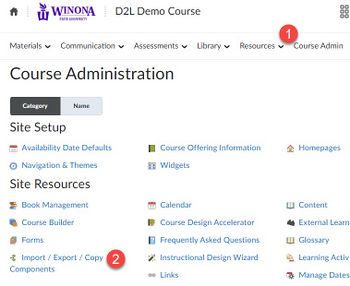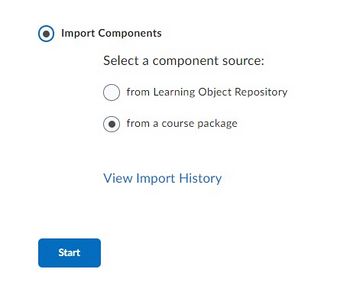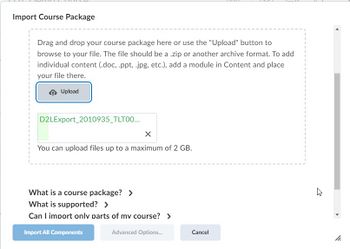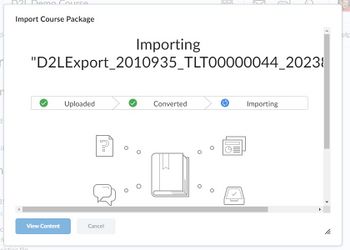Import Brightspace course components
Instructors can import Brightspace course components into their Brightspace courses using export packages they created or that are shared with them by colleagues. Export packages are zip files that contain either all or selected course components (e.g., content, quizzes). Packages do not include student data (e.g., class lists, grades, assignment submissions).
What's a course package or cartridge
When you export a Brightspace course, it generates a file with a .zip extension that you download and save. This special file type includes many other files zipped up into a single file or package. Sometimes these files are called cartridges (e.g., by textbook publishers). You can then unzip or extract all the files from the package later. Brightspace, and other popular LMSs, include an import function that allows you to extract and upload what you want from the export package into another course. Publishers also use these course packages or cartridges to deliver supplementary materials (e.g., test banks, presentations). They typically email the .zip file or provide a link to it and you import it into your Brightspace course as you would a Brightspace course package.
Import a Brightspace package
- Sign in to Brightspace and open the course you want to import or copy into.
- Select Course Admin and then select Import/Export/Copy Components (Fig 1).
- Select the Import Components radio button and the from a course package radio button under Select a component source. Select Start (Fig 2).
- Select the Upload button (Fig 3), find the .zip file on your computer or OneDrive, and select Open to upload the file.
- Select the Import All Components button if you want to import everything. If you want to select components from the export package, pick the Advanced Options... button. Brightspace will begin downloading and reading the package. This may take a few seconds. Select Continue when it's ready.
- If you selected the Advanced Options... button, select which components to import (Fig 4). You can select all components, select all components of a certain type (e.g., all checklists), or select specific items of a certain type (e.g., select some content items and not others). You will also have the option to set some Advanced Options (Fig 5). Typically, you use the default settings, but the options are discussed under Pro Tips below. Select Continue.
- If you opted to select specific items of a certain type, you will be asked to select the items, one type at a time. Continue this process for every item type.
- Confirm your selections. The Advanced Options are presented again in case you want to change any of them. Select Continue and the import process will begin (Fig 6).
- When the import process completes, select View Content to go to the table of contents for your course. You can also import another export package or select Review and Manage Dates to go to the Manage Dates tool.
Pro Tips
- When importing a course package of any sort, never pick Import All Components. Always pick Advanced Options... even if you are going to import everything. This gives you a chance to explore what's in the export package just in case there's stuff in there you don't need.
- One of the Advanced Options is whether to overwrite files with the same filename. The default is "no." Think carefully before changing that. For example, if you are importing from a package that includes a file called syllabus.docx and you choose to overwrite, this file will replace the existing one. If you choose not to overwrite, this file will be added as if it was a unique file. Thus, you may have two topics in your table of contents called Syllabus. Duplication of topics and files can also happen if you upload the same export package to the same course more than once. Contact TLT (tlt@winona.edu) if you ever find yourself in a jam and need to reset your course.
- Any dates and times associated with activities and content will probably need to be adjusted. One of the Advanced Options is Offest all dates of imported components. This can help you get dates into the ballpark in cases where you can calculate the amount of time that has elapsed since the things in the export package were last used. Select Calculate range between two dates to use a calendar to pick the first day of that previous term and the first day of the current term. This will not fix all dates and times, but it will get you within a few days.
- When you import a .zip file, you can use an Advanced Option to specify where in the files area of your course it will save it. It defaults to the root folder of your course, but you could put it into a subfolder if you wish. Most people don't worry too much about under-the-hood file management in D2L, but some do.
- Importing metadata can be important if you are doing things with SCORM and reusable learning objects in your courses. If you are, then check this checkbox in Advanced Options. Otherwise, you don't need to worry about it. If you have questions, contact TLT (tlt@winona.edu).
More wiki articles
- Export Brightspace course components
- Use Brightspace sandbox courses
- Share Brightspace course components
External links
Except where otherwise noted, text is available under the Creative Commons Attribution-NonCommercial-ShareAlike 4.0 International License.





